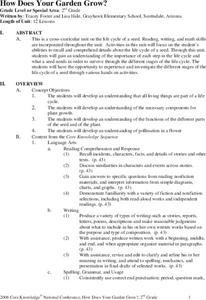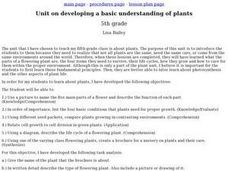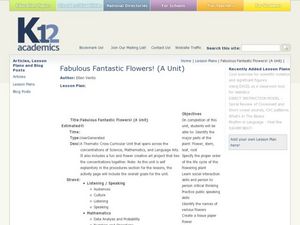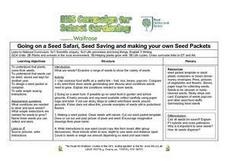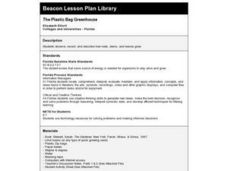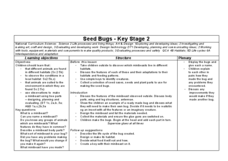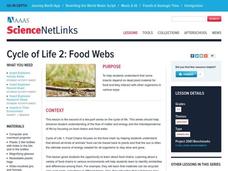Curated OER
Sequence Writing: Life Cycles - Plant Life
Students investigate the stages of plant life. Students create a K-W-L chart. They describe six main stages of the plant life cycles. Using stickers, students create a life cycle flow map.
Curated OER
Life Cycles
Students explore the parts of a flower and pollination of flowers. In this plants lesson, students use an interactive whiteboard to label the parts of a plant and the functions of each part. Students complete a worksheet as an assessment.
Chicago Botanic Garden
Preparing for Project BudBurst
Male deer growing antlers to begin the breeding season is an example of a phenological event. First in a four-part series is an activity requiring individuals to collect phenological data on their campus. Classes discuss phenology, the...
Curated OER
Life Cycle of Brassica Plants: Planting Seeds
Students explore botany by participating in a calendar class activity. In this plant observation lesson, students examine a diagram of a Brassica plant and identify its anatomy before planting their own seeds and viewing the changes over...
Curated OER
How Does Your Garden Grow?
Students complete activities to learn about the life cycle of a seed. In this plant growth lesson, students complete activities for the life cycles of seeds.
Curated OER
Unit on Developing a Basic Understanding of Plants
Fifth graders study the parts of a plant, their life cycles, and how to care for them in this unit.
Curated OER
Fabulous Fantastic Flowers!
Students study flowers and identify their major parts. In this flowers lesson plan, students research flowers, learn about their life cycle, label their major parts, and make tissue paper flowers.
Curated OER
The Circle of Life
Fourth graders examine how the different organisms living in an ecosystem affect one another. In groups, they research a specific ecosystem and present their findings to the class based on the type of organisms found in it. To end the...
Curated OER
Rosa Parks Community Garden
Students explore gardening and nutrition in the Rosa Parks Community Garden. They work in stations to discuss food choices, the life cycles of plants, and mini-composting. After starting in one station, they rotate to try each activity.
Curated OER
Raising Plants
Students investigate the life cycle of plants by growing their own in class. In this botany lesson, students practice using plant vocabulary while they grow their own Wisconsin Fast Plants. Students collaboratively build a...
Curated OER
Something's Fishy
Students study fish habits and traits. In this marine life instructional activity, students complete four learning centers of a fish memory game, a fish habitat study, draw and glue fish craft activity, and a fish read-a-thon. Students...
Curated OER
Going on a Seed Safari
Students describe biology by identifying different plants in class. In this seed lesson, students discuss the process of how a plant grows from seed to leaves. Students attend a field trip to their garden or another park and collect a...
Curated OER
Succession in the Classroom
Middle schoolers investigate their environment by growing plants in class. In this botany lesson plan, students discuss the lifespan of plants and animals and how they must be cared for continuously over time. Middle...
Curated OER
The Plastic Bag Greenhouse
Third graders observe plants and record their growth. They describe the parts of plants in detail including the roots, stems and leaves.
Curated OER
From One Seed Grow Many Seeds
First graders practice identifying plants by singing a song. In this plant life lesson, 1st graders sing the song "Parts of a Plant" which is based on the anatomy of sunflowers. Students discover agriculture techniques while...
Curated OER
How Does Your Garden Grow?
Students discover gardening by documenting plants grown on school grounds. In this botany instructional activity, students utilize digital cameras to capture images of plants on photo hikes which are turned into a slide show....
Curated OER
Industrialization, Chemicals and Human Health - Math
Students review the units of the metric system, and practice estimating measures before actually converting between the two systems of measurement. They participate in activities to visualize a concentration of one part per million....
Curated OER
Seed Diversity
Learners explore agriculture by researching different seeds. In this seed identification lesson, students collaborate in small groups to analyze a package of different seeds. Learners utilize a magnifying glass to examine each seed...
Curated OER
Seed Bugs; Stage 2
Young scholars examine nature by participating in an environmental art activity. In this imaginary creature lesson, students discuss the importance of a habitat when pertaining to wild animals or bugs. Young scholars utilize tree parts...
Curated OER
Population Growth
Learners grow duckweed, observe what happens when an organism population is allowed to grow without predation or competition, view videos about invasive species, and develop a proposal for controlling the growth of an invasive species in...
Curated OER
Where Are the Dinosaurs?
Students examine the concept of extinction by studying dinosaurs. In this living environment lesson, students view dinosaur video clips and define the word "extinction." Students visit the "Zoom Dinosaur" website to investigate various...
Curated OER
Creating a Food Web
Students investigate hunters and prey by creating a food web. In this animal life lesson, students investigate a single organism in preparation for a field trip, discovering its diet and habitat. Students each discuss their...
Curated OER
Photosynthesis and Cell Respiration
Fifth graders participate in scientific inquires regarding the concepts of photosynthesis and cell respiration. In this photosynthesis and cell respiration instructional activity, 5th graders describe the process of photosynthesis with...
Curated OER
Food Web Follies
Seventh graders cut and paste animal pictures to create a food web and trace the path of energy. They write a paragraph explaining the importance of photosynthesis in all food webs.




